Excess skin is often an unfortunate consequence of weight loss with Lapband surgery.
Factors Contributing to Flabby Skin
Exactly how much flabby skin you are likely to have to deal with depends on the following factors:
Total Weight Loss
Those people who lose a significant percentage of their body weight are more likely to have to deal with flabby skin than those who have less to lose. This is because when you have a significant amount of excess weight the body produces new skin cells in order to hold the excess and these do not disappear once you lose weight.
Speed of Weight Loss
You are more likely to have to deal with flabby skin if you lose weight rapidly than if you do so slowly over a longer period of time which gives your skin more of a chance to adapt over time.
Age
As skin loses elasticity with age, people who are older are more likely to have to deal with flabby skin than people who have Lapband surgery when they are younger.
Genetics
Some people are predisposed to flabby skin than others simply by virtue of the genes they were born with.
Strategies for Minimising Flabby Skin
Unfortunately there is no method guaranteed to minimise flabby skin as a result of weight loss.
However, Lapbanders have discussed and used the following strategies:
Diet
There are a number of foods and nutrients that are recognised as providing skin with the raw materials it needs to repair and renew itself.
For good skin eat foods rich in calcium (found in dark green leafy vegetables, sardines with bones and yoghurt), Vitamin C (eg Oranges) and high water content (like watermelons and other fruits).
Try to avoid fried foods, chocolate, alcohol and caffeine because they deprive the body of necessary nutrients and moisture.
Exfoliation
You can exfoliate your skin either by using:
- An abrasion mitt, sponge or loofah; or
- Scrubs (preferably with a fine gritty texture); or
- Acid-based creams (such as those containing Alpha Hydroxy Acids (AHAs) or salicyclic acid).
The theory behind this strategy is that exfoliation encourages your skin to renew itself more often than it might otherwise throughout the entire weight loss process.
Moisturising Creams
You could apply a number of different creams or oils to moisturise the skin. Creams containing Vitamin E are often recommended to help pregnant women minimise stretch marks.
The theory behind this strategy is that the creams help to nourish and repair the skin.
Body Shapers, Smoothies, Girdles, Shapers, Foundation Garments
These all work by pulling the skin together and holding it in to remove bumps and bulges. Some believe that wearing these garments can help encourage the skin to shrink back into shape as they do for burn victims.
Exercise
Although exercise does not directly affect the skin it can help decrease the level of flabbiness by building the muscle underneath. Skin looks a lot less saggy when it has strong defined muscle visible beneath it.
What about Plastic Surgery?
If you find that you are left with large amounts of excess flabby skin once you have reached your goal, and maintained it for at least twelve months - but preferably 2-5 years, you may want to consider plastic surgery.
A plastic surgeon will be able to discuss your specific requirements and recommend the most appropriate form(s) of surgery as well as the associated costs and risks.
The most common forms of surgery following weight loss are outlined below. Much of the information is available in "A Consumers Guide to Cosmetic Plastic Surgery in New Zealand" which is published by the NZ Foundation for Cosmetic Plastic Surgery. For details on how to order a copy of this booklet visit the NZFCPS website.
Abdomen
The most common form of surgery following a substantial weight loss is what is commonly described as a "tummy tuck" or bikini-line abdominoplasty.
An abdominoplasty involves the removal of excess fat and skin using a combination of liposcultpure and an excision. Often it will also involve the repair of overdistended muscles resulting from the pressure exerted by body fat before weight loss
During the procedure loosened skin and fat is pulled towards the pelvic area and any excess is removed.
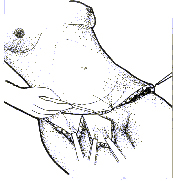
An abdominoplasty typically leaves a low scar just above the pubis going up slightly on either side.
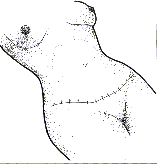
The procedure can give patients a leaner look as evidenced in the following before and after pictures (taken from Bermant Plastic and Cosmetic Surgery website):
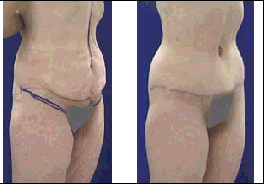
The costs of the procedure will vary considerably depending on the extent, type and duration of the surgery. You can expect to pay between $1500 to $4,500 for the surgeon, $500 to $1000 for the theatre, $300 per night for the hospital (for 1-3 nights) and $350-$950 for the anaesthetist.
An abdominoplasty is often associated with a weight loss of between 2-3 kgs.
Although the abdominoplasty is the most common form of plastic surgery for this area there are other alternatives which you may wish to discuss with your plastic surgeon. A panniculectomy is a less invasive surgery which involves only the removal of skin without muscle tightening. A body lift or belt lipectomy is a more invasive surgery which involves the lifting and tightening of skin around the buttocks and hips as well as the abdomen.
Breasts
Breast reduction surgery can help to recreate normal shape and volume following weight loss.
In breast reduction a keyhole-shaped incision is made and the nipple is moved up into it's new position. The nipple size is adjusted and the newly shaped breast is sutured.
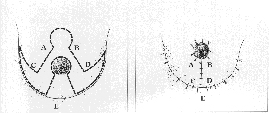
The procedure can dramatically improve the breast profile as evidenced in the following before and after pictures (taken from Bermant Plastic and Cosmetic Surgery website):
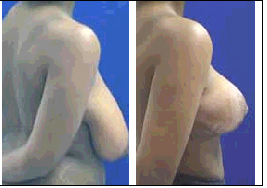
The costs of the procedure will vary depending on the extent of the repositioning but you can expect to pay between $3500 to $4500 for the surgeon, $750-1400 for the theatre, $300 per night for the hospital and $650 to $1000 for the Anaesthetist.
Breast reduction is often associated with a further weight loss of 1-2 kgs.
Arms
An arm lift removes excess tissue and reduces the circumference of the arm.
If you only have a small amount of excess skin it may be possible for any scarring to be hidden in your armpit. However, in most cases, the surgery will leave a long scar on the underside of the arm.
Inner Thighs
A thigh lift removes the excess fat and skin in the inner thigh area.
The scar can be hidden at the root of the thigh depending on the amount of work that needs to be done in that area.
A thigh lift is often associated with a further weight loss of 1.5kg for each thigh.
It is important to note that healing often takes longer than usual because the scar is located in a fold which is very mobile and is also prone to steep.
Face
A face lift tightens drooping and excess skin which can occur around the face and neck after substantial weight loss.
During the procedure incisions are made along lines marked out by the surgeon and the skin is gradually lifted and peeled off the deeper tissues in front of the ears and over the side of the head above the hair line. Any excess fat beneath the skin is either suctioned or removed and the superficial muscles of the neck may be tightened.

The skin is then trimmed and tailored to fit its new position along and behind the ear. Just enough tension is applied to make the face look firm without making it look mask-like or changing the shape of the eyes or mouth. Soft rubber or nylon drains may be placed under the skin to drain away blood or fluid. These are removed at a later date. The wounds are then sutured.

It is unusual for patients to be left with any obvious scarring after a face lift. The only visible scar runs from behind the ear, into the scalp, and this can usually be easily hidden by the hair and makeup.
The costs of the procedure can vary depending on the extent, type and duration of the surgery. You can expect to pay between $2500 to $5,500 for the surgeon, $1100 to $1400 for the theatre, $300 per night for the hospital and $700-$1200 for the anaesthetist.
Further Information
For more information regarding these procedures and the associated risks and potential complications refer to the following resources:
NZ Foundation for Cosmetic Plastic Surgery
http://www.nzcosmeticsurgery.org.nz/
Contains a reference to the Foundation's publication titled "A Consumers Guide to Cosmetic Plastic Surgery in New Zealand" and details how to obtain a copy. The site also lists the members of the foundation.
Plastic Surgery Information Service
http://www.plasticsurgery.org/
Contains extensive descriptions and diagrams explaining the main forms of plastic surgery as well as a helpful section on Frequently Asked Questions.
Obesity Surgery Support Group: Plastic Surgery Discussion List
http://www.egroups.com/group/ossg-plasticsurgery
This discussion list is a spin-off of the original Support Group list and is dedicated to discussion of the various forms of Plastic surgery following weight loss and related topics.
Scarring
Laparoscopic surgery will leave you with approximately five small scars on your stomach. These scars should fade away and become almost unnoticeable over time.
An Australian surgeon suggests that you can minimise scarring by keeping your wounds covered with fresh clean tape for a full six weeks following surgery.
If you are wanting to do everything you can to minimise scarring you should also observe many of the hints listed above and you may want to take a look at the following products:
Vitamin E Creams and Oils
Vitamin E has been associated with healing the skin. To get optimal scar reducing benefit from a Vitamin E cream you will need to purchase one that has a minimum of 5000 ICUs. Jasons markets a range of Vitamin E products including an oil with a concentration as high as 45000 ICUs.
Mederma
This product is marketed as a cream that can make a scar appear smoother and less noticeable no matter how long you've had it. Visit their website (http://www.mederma.com) for more information.
Cica-Care Adhesive Silicone Gel Sheets
This is marketed as a product which can help to heal your surgical wounds and reduce the appearance of scars. Visit their website (http://www.cicacare.com) for more information.
ScarGuard
A clear film product, fortified with Vitamin E, which protects a scar during healing but is also marketed as being able to soften, shrink and fade older scars as well. For more information visit their website (http://www.scarguard.com/index.html).
If you choose to use the strips you should be aware that they can be difficult to keep in place but that you can overcome this by using surgical tape to help secure it. Some Lapbanders have found the strips too sticky and uncomfortable to use for the extended lengths of time suggested by the manufacturers.

